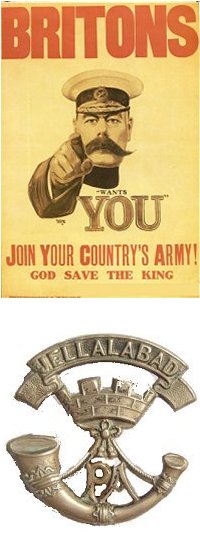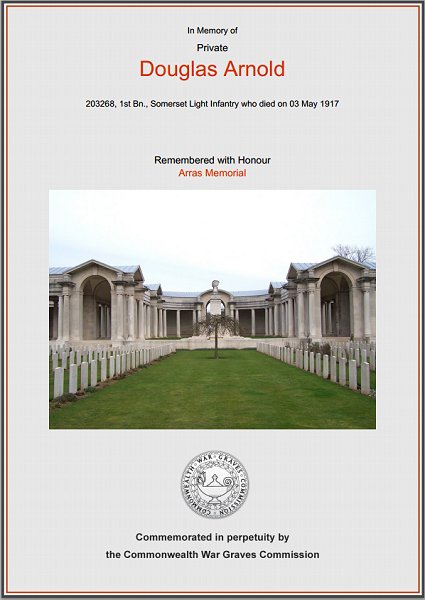yeovil at War
Douglas arthur Arnold
A 20-year old lad, killed on his first day in the front line
Douglas Arthur Arnold was born in Yeovil in 1897, the youngest child of glove cutter Herbert Arnold (b 1871) and his glove liner wife Florence (b 1873). In the 1901 census Herbert and Florence Arnold were listed at 7 Frederick Place with their children; Winifred aged eight, Lesley aged seven and Douglas age four. They were still living there in 1911 at which time there was a new daughter, Violet. Douglas, now aged 14, was working as a counting room assistant. The family later moved to 115 Goldcroft.
 On
1 January 1917
Douglas enlisted
in the Army at
Yeovil. He
became Private
Douglas Arnold
(Serial No
203268) of 1st
Battalion,
Somerset Light
Infantry.
On
1 January 1917
Douglas enlisted
in the Army at
Yeovil. He
became Private
Douglas Arnold
(Serial No
203268) of 1st
Battalion,
Somerset Light
Infantry.
After his period of basic training, Douglas was sent to France to join his Battalion which, at this time, was heavily involved in the Second Battle of Arras.
The Second Battle of Arras, fought between 9 April and 16 May 1917, was the British contribution to the Allied spring offensive of 1917. The original Allied plan for 1917, agreed at the Chantilly conference of November 1916, was for a second offensive on the Somme, but that plan was abandoned after a change of French leadership and it was decided that the British would attack around Arras and involve troops from three armies. In the north the Canadian corps of the First Army would attack Vimy Ridge. In the centre of the line the Third Army under General Allenby would attack from Arras. Finally, the British Fifth Army under General Gough would attack on the right of the line. The entire British attack was supported by 2,879 guns each of which had close to 1,000 shells. The British attack made impressive progress, but it did not achieve a breakthrough on the first day, allowing the Germans to rush their reinforcements into the gap and launch a series of counterattacks thereby slowing down the British attack. A renewed British attack at Bullecourt on 11 April failed to make any progress and the attack was suspended. The month of fighting around Arras cost the British 84,000 casualties and the Germans 75,000. Tactically it was a clear British victory, but the overall plan to cut off the German salient had failed.
Douglas reached his unit in the front-line trenches on 2 May 1917. At this time the Battalion was preparing itself for the Third Battle of the Scarpe and the role of the 1st Battalion is told in the Regimental History of the Somerset Light Infantry - "The last of the Battles of Arras, 1917, which opened on 3 May, was of a similar nature to the operations of 28 and 29 April. The French had planned a heavy attack on Chemin des Dames to take place on the 5th and, in order to distract the attention of the enemy and hold his troops east of Arras, Sir Douglas Haig considerably extended his active front. While the Third and First Armies attacked from Fontaine-les-Croisilles to Fresnoy the Fifth Army was to launch a second attack upon the Hindenburg Line in the neighbourhood of Bullecourt - a total of over 16 miles.
Zero hour was timed for 3:45am on 3 May. In these final operations the 1st Battalion Somerset Light Infantry (4th Division) and the 6th Battalion (14th Division) were engaged. Neither of these Battalions had been engaged with the enemy after the close of the First Battle of the Scarpe on 14 April. The 14th Division having relieved the 4th Division on 20 April, the 1st Somersets moved out of the line and did not go in again until 2 May (when Douglas Arnold joined them)....
On the 1st Battalion, however, fell the brunt of an attack which, though gallantly made, was unsuccessful and was the cause of the loss of many brave fellows. The 1st Somersets moved from the ravine NW of Athies at 8pm on 2 May to take up positions in the front line north of the River Scarpe and west of Roeux Woods. On leaving Athies the Battalion crossed the river to the southern side and, moving forward along the railway, crossed the river a gain to the Northern bank about 1,000 yards west of Roeux Woods. Some shelling was encountered, but no casualties were suffered, and by midnight the Battalion was in position: it's attacking strength was then 9 officers and 217 other ranks.
It was very dark and dull when, at 3:15am - Zero Hour - the attack, under an artillery barrage, was launched. The assaulting troops went forward perfectly to time, but were immediately met by intense fire from the German machine guns of which Roeux Woods appeared to shelter a large number. The Wood had apparently been missed by the barrage, probably its close proximity to the British front-line induced the gunners to avoid the risk of short shooting. The trench mortars of the 10th Brigade which were supposed to mortar the Wood before the attack began were ineffective. The Somerset men, however, got into the Wood and, although touch was lost owing to the darkness and confusion, the left of the attack succeeded in reaching the western outskirts of Roeux village, but were unable to remain there for they were too few in numbers and the enemy's machine gun and rifle fire was very heavy. The right of the attack had been held up in the Wood. Eventually both the right and left of the attack dribbled back to their original trenches, having gained nothing but the honour of reaching Roeux, though unable to hold it. Back in their original trenches the survivors of the Battalion reorganised and counted their losses."
Of the 1st Battalion, three officers were killed and five wounded. In other ranks the Battalion had lost 132 killed, wounded and missing. This included Private Douglas Arnold, killed in action on 3 May 1917 - his first day of battle. He was aged just 20.
On 11 May 1914 the Western Gazette reported "Mr and Mrs H Arnold, of Goldcroft, have received a letter from a Bridgwater soldier informing them that their youngest son, Private Douglas Arnold, Somerset LI, has been killed in action. Deceased joined up on January 1st, and was only 20 years of age."
A second report in the Western Gazette, dated 1 June 1917, stated "Official notification has now been received that Private Douglas Arthur Arnold, Somerset LI, younger son of Mr and Mrs H Arnold, of 115 Goldcroft, was killed in action on May 3rd. Private Arnold, who was only 20 years of age, joined up about four months before, and had only been in the front line one day. His brother has been serving at the Front for 12 months. Mrs Arnold has also received a letter from the officer commanding the Company to which Private Arnold belonged as follows:- “Dear Madam, - I very much regret that your son No. 203268 Priv. Arnold, was killed on the 3rd inst. He had not been out here very long, but he bore himself most gallantly. Please accept my sincere sympathy in your great sorrow.”
Douglas Arnold is commemorated on Bay 4 of the Arras Memorial, and his name is inscribed on the War Memorial in the Borough.
gallery

The Commonwealth War Graves Commission certificate in memory of Ben Pike.